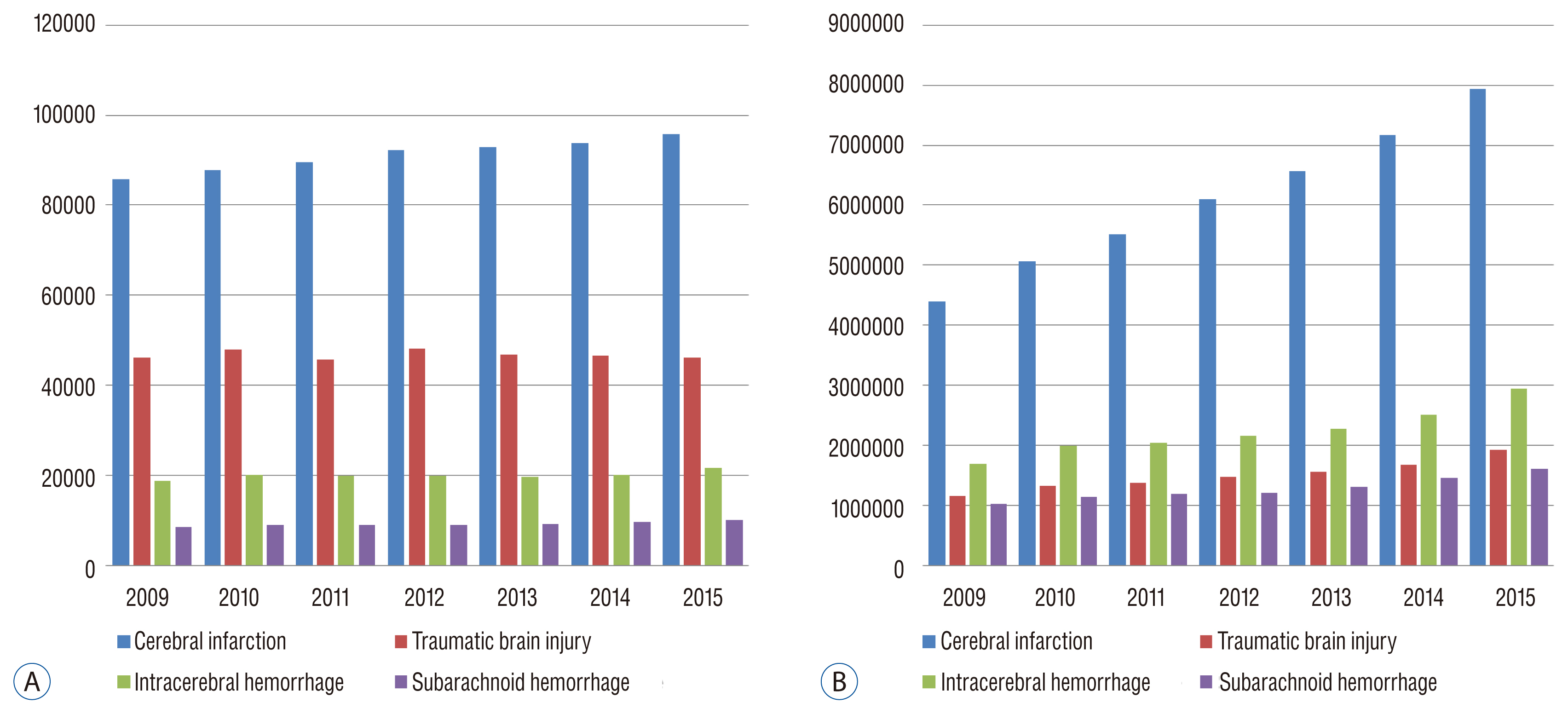J Korean Neurosurg Soc.
2018 Jan;61(1):105-113. 10.3340/jkns.2017.0303.006.
Geographic Analysis of Neurosurgery Workforce in Korea
- Affiliations
-
- 1Department of Neurosurgery, Urology, Soonchunhyang University Hospital Seoul, Seoul, Korea. j7chang@schmc.ac.kr
- 2Department of Neurosurgery, Soonchunhyang University Hospital Seoul, Seoul, Korea.
- 3Department of Neurosurgery, Soonchunhyang University Hospital Gumi, Gumi, Korea.
- KMID: 2403530
- DOI: http://doi.org/10.3340/jkns.2017.0303.006
Abstract
OBJECTIVE
In respect of the health and safety of the public, universal access to health care is an issue of the greatest importance. The geographic distribution of doctors is one of the important factors contributing to access to health care. The aim of this study is to assess the imbalances in the geographic distribution of neurosurgeons across Korea.
METHODS
Population data was obtained from the National Statistical Office. We classified geographic groups into 7 metropolitan cities, 78 non-metropolitan cities, and 77 rural areas. The number of doctors and neurosurgeons per 100000 populations in each county unit was calculated using the total number of doctors and neurosurgeons at the country level from 2009 to 2015. The density levels of neurosurgeon and doctor were calculated and depicted in maps.
RESULTS
Between 2009 and 2015, the number of neurosurgeons increased from 2002 to 2557, and the ratio of neurosurgeons per 100000 populations increased from 4.02 to 4.96. The number of neurosurgeons per 100000 populations was highest in metropolitan cities and lowest in rural areas from 2009 to 2015. A comparison of the geographic distribution of neurosurgeons in 2009 and 2015 showed an increase in the regional gap. The neurosurgeon density was affected by country unit characteristics (p=0.000).
CONCLUSION
Distribution of neurosurgeons throughout Korea is uneven. Neurosurgeons are being increasingly concentrated in a limited number of metropolitan cities. This phenomenon will need to be accounted when planning for a supply of neurosurgeons, allocation of resources and manpower, and the provision of regional neurosurgical services.
MeSH Terms
Figure
Cited by 2 articles
-
Infectious Diseases Physician Workforce in Korea
Youngeun Jang, Se Yoon Park, Bongyoung Kim, Eunjung Lee, Seungjae Lee, Hyo-Ju Son, Jung Wan Park, Shi Nae Yu, Tark Kim, Min Hyok Jeon, Eun Ju Choo, Tae Hyong Kim
J Korean Med Sci. 2020;35(49):e428. doi: 10.3346/jkms.2020.35.e428.Endovascular Treatments Performed Collaboratively by the Society of Korean Endovascular Neurosurgeons Members : A Nationwide Multicenter Survey
Tae Gon Kim, Oki Kwon, Yong Sam Shin, Jae Hoon Sung, Jun Seok Koh, Bum-Tae Kim
J Korean Neurosurg Soc. 2019;62(5):502-518. doi: 10.3340/jkns.2018.0216.
Reference
-
References
1. Bean JR. Neurosurgical emergency and trauma services: legal, regulatory, and socioeconomic barriers. Clin Neurosurg. 54:149–152. 2007.2. Chung HS KJ, Park HK, Lee WJ, Han DU. Future need and supply of practicing doctors ini total and by speciality. Yonsei Institute for Health and Welfare. 2011.3. Dunbabin JS, Levitt L. Rural origin and rural medical exposure: their impact on the rural and remote medical workforce in Australia. Rural Remote Health. 3:212. 2003.4. Ecker RD, Levy EI, Hopkins LN. Workforce needs for endovascular neurosurgery. Neurosurgery. 59(5 Suppl 3):S271–S276. discussion S3–S13. 2006.
Article5. Friedlich DL, Feustel PJ, Popp AJ. Workforce demand for neurosurgeons in the United States of America: a 13-year retrospective study. J Neurosurg. 90:993–997. 1999.
Article6. Hankinson TC, Bohman LE, Vanaman M, Egorova N, Mocco J, Orrico KO, et al. Geographical neurosurgery workforce analysis from 1990 to 2005 improves our understanding of the role of market factors. Clin Neurosurg. 55:145–149. 2008.7. Harbrecht BG, Smith JW, Franklin GA, Miller FB, Richardson JD. Decreasing regional neurosurgical workforce-a blueprint for disaster. J Trauma. 68:1367–1372. discussion 1372–1374. 2010.
Article8. Kamalakanthan A, Jackson S. Doctor supply in Australia: rural–urban imbalances and regulated supply. Aust J Prim Health. 15:3–8. 2009.9. Laven G, Wilkinson D. Rural doctors and rural backgrounds: how strong is the evidence? A systematic review. Aust J Rural Health. 11:277–284. 2003.
Article10. Lee SJ, Park HK, Park TH, Lee KB, Bae HJ, Rha JH, et al. Stroke system of care: a policy statement from the Korean Stroke Society. J Korean Neurol Assoc. 33:226–228. 2015.
Article11. Murphy J. Care of the patient with traumatic brain injury: urban versus rural challenges. Adv Emerg Nurs J. 26:231–236. 2004.12. Oncel MY, Ozdemir R, Kahilogulları G, Yurttutan S, Erdeve O, Dilmen U. The effect of surgery time on prognosis in newborns with meningomyelocele. J Korean Neurosurg Soc. 51:359–362. 2012.
Article13. Organization for Economic Cooperation and Development. Health at a glance 2013: OECD indicators. Paris: OECD Publishing;2013. p. 63–67.14. Reulen HJ, Hide RA, Bettag M, Bodosi M, Cunha E Sa M. A report on neurosurgical workforce in the countries of the EU and associated states. Task force “Workforce planning”, UEMS section of neurosurgery. Acta Neurochir (Wien). 151:715–721. 2009.
Article15. Rourke J. Increasing the number of rural physicians. CMAJ. 178:322–325. 2008.
Article16. Simoens S, Hurst J. The supply of physician services in OECD countries. OECD health working papers, No. 21. Paris: OECD;2006. p. 38–49.17. Simonet D. Healthcare reforms and cost reduction strategies in Europe: the cases of Germany, UK, Switzerland, Italy and France. Int J Health Care Qual Assur. 23:470–488. 2010.18. Walker R, Whiting D, Unwin N, Mugusi F, Swai M, Aris E, et al. Stroke incidence in rural and urban Tanzania: a prospective, community-based study. Lancet Neurol. 9:786–792. 2010.
Article19. Woods R. Urban-rural mortality differentials: an unresolved debate. Popul Dev Rev. 29:29–46. 2003.
Article
- Full Text Links
- Actions
-
Cited
- CITED
-
- Close
- Share
- Similar articles
-
- A Critical Review of Nurse Demand Forecasting Methods in Empirical Studies 1991~2014
- Correlation between Topographic Progression of Geographic Atrophy and Visual Acuity Changes
- Two Cases of Combined Geographic Tongue and Fissured Tongue in Generalized Pustular Psoriasis
- The Effect of Geographic Units of Analysis on Measuring Geographic Variation in Medical Services Utilization
- Prevalence and Geographic Distribution of Herniated Intervertebral Disc in Korean 19-Year-Old Male from 2008 to 2009: A Study Based on Korean Conscription: National and Geographic Prevalence of Herniated Intervertebral Disc in Korean 19YO Male




